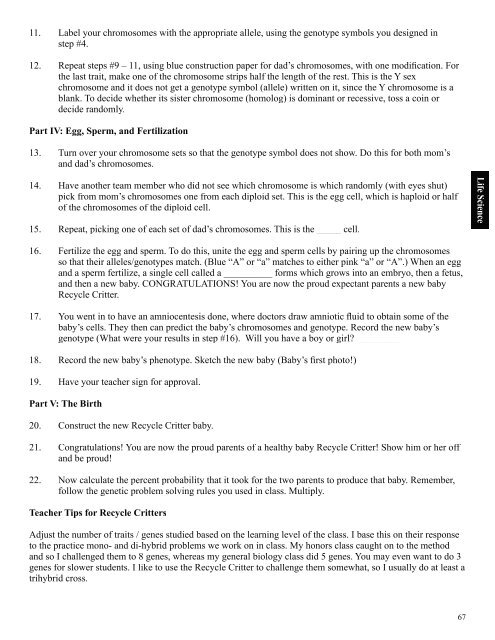ScienceMakers Toolkit Manual - The History Makers
ScienceMakers Toolkit Manual - The History Makers
ScienceMakers Toolkit Manual - The History Makers
You also want an ePaper? Increase the reach of your titles
YUMPU automatically turns print PDFs into web optimized ePapers that Google loves.
11. Label your chromosomes with the appropriate allele, using the genotype symbols you designed in<br />
step #4.<br />
12. Repeat steps #9 – 11, using blue construction paper for dad’s chromosomes, with one modifi cation. For<br />
the last trait, make one of the chromosome strips half the length of the rest. This is the Y sex<br />
chromosome and it does not get a genotype symbol (allele) written on it, since the Y chromosome is a<br />
blank. To decide whether its sister chromosome (homolog) is dominant or recessive, toss a coin or<br />
decide randomly.<br />
Part IV: Egg, Sperm, and Fertilization<br />
13. Turn over your chromosome sets so that the genotype symbol does not show. Do this for both mom’s<br />
and dad’s chromosomes.<br />
14. Have another team member who did not see which chromosome is which randomly (with eyes shut)<br />
pick from mom’s chromosomes one from each diploid set. This is the egg cell, which is haploid or half<br />
of the chromosomes of the diploid cell.<br />
15. Repeat, picking one of each set of dad’s chromosomes. This is the _____ cell.<br />
16. Fertilize the egg and sperm. To do this, unite the egg and sperm cells by pairing up the chromosomes<br />
so that their alleles/genotypes match. (Blue “A” or “a” matches to either pink “a” or “A”.) When an egg<br />
and a sperm fertilize, a single cell called a __________ forms which grows into an embryo, then a fetus,<br />
and then a new baby. CONGRATULATIONS! You are now the proud expectant parents a new baby<br />
Recycle Critter.<br />
17. You went in to have an amniocentesis done, where doctors draw amniotic fl uid to obtain some of the<br />
baby’s cells. <strong>The</strong>y then can predict the baby’s chromosomes and genotype. Record the new baby’s<br />
genotype (What were your results in step #16). Will you have a boy or girl? _________<br />
18. Record the new baby’s phenotype. Sketch the new baby (Baby’s fi rst photo!)<br />
19. Have your teacher sign for approval.<br />
Part V: <strong>The</strong> Birth<br />
20. Construct the new Recycle Critter baby.<br />
21. Congratulations! You are now the proud parents of a healthy baby Recycle Critter! Show him or her off<br />
and be proud!<br />
22. Now calculate the percent probability that it took for the two parents to produce that baby. Remember,<br />
follow the genetic problem solving rules you used in class. Multiply.<br />
Teacher Tips for Recycle Critters<br />
Adjust the number of traits / genes studied based on the learning level of the class. I base this on their response<br />
to the practice mono- and di-hybrid problems we work on in class. My honors class caught on to the method<br />
and so I challenged them to 8 genes, whereas my general biology class did 5 genes. You may even want to do 3<br />
genes for slower students. I like to use the Recycle Critter to challenge them somewhat, so I usually do at least a<br />
trihybrid cross.<br />
67<br />
Life Science










